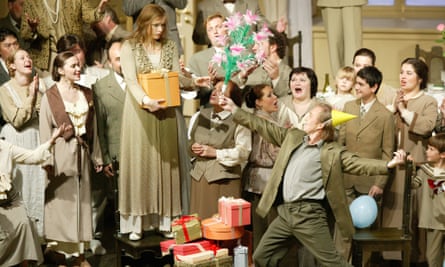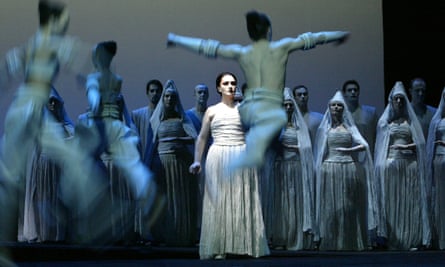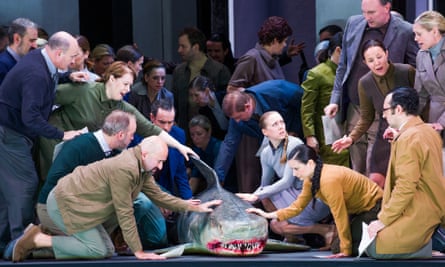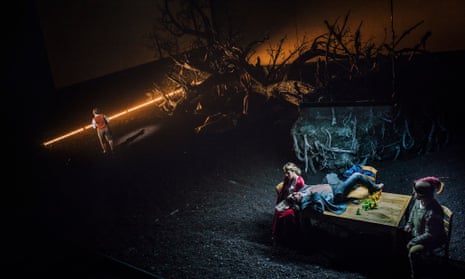- The Death of Klinghoffer – directed by Tom Morris, English National Opera, London, 2012 and Met Opera, New York, 2014

Directed by Tom Morris (brother of Chris), this production of John Adams’s 1991 opera about by the hijacking of the cruise liner Achille Lauro, during which the Jewish American holidaymaker Leon Klinghoffer was murdered by terrorists, caused muted protests when it was staged at the English National Opera in 2012. At the Met in New York two years later, it was a different story; the production was picketed by hundreds of protestors and its first night was interrupted by boos and catcalls. While a cinema simulcast was scrapped, the performances went ahead.
2. Die Meistersinger von Nürnberg – directed by Katharina Wagner, Bayreuth, 2007
For her debut at the festival dedicated to the work of her great-grandfather Richard Wagner, Katharina directed a Meistersinger which had the audience making their displeasure clear. She updated the action, making the amateur singers of the title artists and manically typing poets, and subverted its hymn to the glories of German art with a sequence in which greats from Goethe to Wagner do a chorus-line routine. “You left thinking you hadn’t really seen the opera,” concluded the New York Times.
3. A Masked Ball – directed by Calixto Bieito, Liceu, Barcelona, 2000 and ENO, London, 2002
The Spanish theatre director Bieito caused a furore when it was disclosed that his version of Verdi’s opera would include the rape and murder of a male youth, cross-dressing, male and female nudity and a scene in which the chorus sang while sat on the toilet – decisions which were said to have led tenor Julian Gavin to turn down the leading role. After all that, however, the production received good reviews,with the Guardian’s critic concluding: “Bieito wants to heighten responses, to bring out what is buried, and that seems to me the primary responsibility of any opera director.”
4. Mazeppa – directed by David Alden, ENO, London 1984
Featuring bodies hung on meathooks, buckets of blood and an extremely graphic chainsaw massacre, Alden brought splatter-film aesthetics to Tchaikovsky’s opera and made his reputation as the opera world’s enfant terrible. “When the orgy of slashing closed the first act, I damned nearly threw up all over the chap sitting in front of me,” said the Spectator’s critic. “And the fact that he happened to be the ENO’s director of productions suggests that there may be justice in this world after all.”
5. Lohengrin – directed by Hans Neuenfels, Bayreuth, 2010
Germany’s Wagner festival has never lacked for avant garde takes on the master’s operas, however much the devotees who attend might complain. Sure enough, they booed heartily at Neuenfels’s interpretation, which depicted most of the opera’s characters as rats in a laboratory, with only the four main roles as fully human. While the audience may not have liked it, the New York Times described the production as “provocative and insightful”.
6. Eugene Onegin – directed by Dmitri Tcherniakov, Bolshoi, Moscow, 2006 and Royal Opera, London, 2010

Updating the opera to the 1960s and replacing the duel between Lensky and Onegin with a scene in which the former accidentally shoots himself, Tcherniakov provided a heightened take on Tchaikovsky in which, said our critic, “everything is pushed to neurotic extremes” – though some found the opera barely recognisable.
7. Der Ring des Nibelungen – directed by Richard Jones, Royal Opera, London, 1994-96
Roger Scruton described Jones’s interpretation of opera’s most imposing work as a “desecration”. The director put the Rhinemadens in Latex nude suits, depicted Freia, the goddess of youth, as a doll-clutching victim of arrested development and turned Wotan into the white-coated boss of a lunatic asylum. The Rhinegold itself was a bucket of women’s shoes: “Foot-fetishism plays a major role in this production,” mused the Independent.
8. Tannhäuser – directed by Burkhard Kominski, Deutsche Oper am Rhein, 2013

Wagner’s work has never been short on controversial interpretations, but Kominski went too far for Dusseldorf when he set Tannhäuser during the Nazi regime in an attempt to address Wagner’s antisemitism. One scene saw naked actors lowered into gas chambers; another depicted Venus as an SS officer who forces Tannhäuser to commit murder. After the shock left some audience members in need of medical attention, further performances were cancelled.
9. Aida – directed by Robert Wilson, Monnaie, Brussels, 2002 and Royal Opera, 2003

Known for his avant garde productions, including his seminal collaboration with Philip Glass, Einstein on the Beach, Robert Wilson was never going to deliver an Aida replete with elephants and pyramids. The Covent Garden audience, however, was distinctly unamused by an abstract and highly symbolic production in which, the Guardian said, “each character moves about the stage with studied deliberation, as if swimming through treacle.”
10. Anna Nicole – directed by Richard Jones, Royal Opera, London, 2011 and Brooklyn Academy of Music, New York, 2013
Having taken on Wagner’s Ring, Richard Jones went to the opposite extreme with at Mark-Anthony Turnage’s opera about the ill-fated Playboy playmate who married an octogenarian oil magnate. One aria by Nicole-Smith’s son consisted of a list of drugs he was on, but the bad taste was intentional and the opera was well-received.
11. Die Entfuhrung aus dem Serail – directed by Calixto Bieito, Komische Oper, Berlin, 2004
Bieito again, who turned Mozart’s light opera about Christian women held in a Turkish harem into an all-out S&M brothel scenario including masturbation, fetishism, singers urinating on one another and a scene including nipple-slicing. The 2004 production cemented his reputation as the “Quentin Tarantino of opera”.
12. Idomeneo – directed Martin Kusej, Royal Opera, 2014

Audiences wondered whether Covent Garden had jumped the shark when they witnessed Martin Kušej’s version of Mozart’s great opera. Intended to explore the psychological impact of regime change on the populace, the production included mysterious symbolism such as the character Arbace carrying an accordion, and a scene in which Athenians gathered around a dead shark.

Comments (…)
Sign in or create your Guardian account to join the discussion